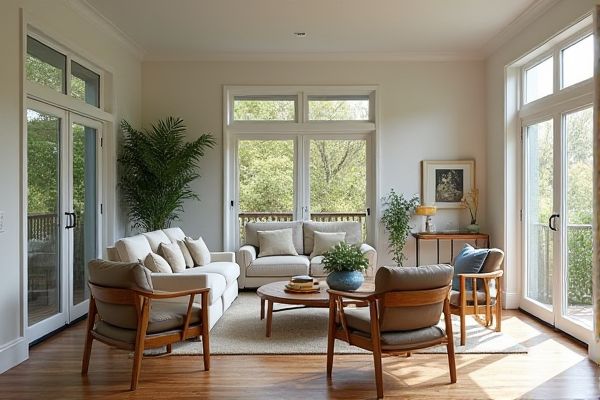
Lounging zones in sunrooms focus on comfort and relaxation with cozy seating and soft lighting, while dining zones prioritize functionality with tables and chairs designed for meals and social gatherings. Discover how to optimize Your sunroom by choosing the right zone setup to enhance both leisure and dining experiences in the full article.
Table of Comparison
| Feature | Lounging Zone Sunroom | Dining Zone Sunroom |
|---|---|---|
| Primary Use | Relaxation and leisure seating | Meals and social dining |
| Furniture | Sectional sofas, lounge chairs, coffee tables | Dining table, chairs, buffet cabinets |
| Design Focus | Comfort and coziness with soft cushions | Functionality and space for serving food |
| Lighting | Ambient and natural light for relaxation | Bright, task lighting for eating |
| Accessories | Throw pillows, rugs, small plants | Table settings, centerpieces, dining accessories |
| Space Layout | Open with flexible seating arrangements | Defined area centered around dining table |
| Ideal For | Reading, napping, casual conversation | Family meals, entertaining guests |
| Weather Adaptation | Cozy blankets or throws for chilly days | Weatherproof dining furniture for outdoor feel |
Introduction to Sunroom Zoning
Sunroom zoning divides the space into distinct lounging and dining zones to maximize functionality and comfort. The lounging zone features soft seating, ambient lighting, and cozy textiles for relaxation, while the dining zone includes a sturdy table, ergonomic chairs, and adequate lighting for meals. Effective zoning enhances the sunroom's usability by catering to both leisure and dining activities within the same area.
Defining Lounging Zones in Sunrooms
Lounging zones in sunrooms are designed to maximize comfort with plush seating, soft cushions, and relaxed arrangements that encourage extended relaxation and casual gatherings. These areas typically feature lounge chairs, sofas, and coffee tables, emphasizing a cozy atmosphere ideal for reading, napping, or enjoying scenic views. Defining your lounging zone involves prioritizing comfort and tranquility, distinguishing it clearly from functional dining spaces.
Characteristics of Dining Zones in Sunrooms
Dining zones in sunrooms feature sturdy, moisture-resistant furniture designed to withstand fluctuating temperatures and humidity levels. These areas prioritize functionality with tables and chairs that facilitate comfortable meals amid natural light and scenic views. Your sunroom's dining zone often includes accessories like easy-to-clean surfaces and strategically placed lighting to enhance meal times without compromising the room's airy ambiance.
Purpose and Functionality: Relaxation vs. Entertaining
A lounging zone in a sunroom is designed primarily for relaxation, featuring comfortable seating such as sofas and chaise lounges that encourage unwinding and enjoying natural light. In contrast, a dining zone emphasizes entertaining, equipped with a table and chairs to facilitate meals and social gatherings. Your choice between these zones should align with whether you prioritize serene personal downtime or hosting lively group interactions.
Furniture Selection for Lounging and Dining Areas
Choosing furniture for lounging zones in sunrooms emphasizes comfort and relaxation, featuring plush sofas, reclining chairs, and soft cushions designed for extended seating. Dining zones require sturdy, space-efficient tables and chairs made from weather-resistant materials like wicker or treated wood to accommodate meals and social gatherings. Both areas benefit from versatile, modular pieces that maximize functionality and maintain a cohesive aesthetic within sunroom environments.
Spatial Layout and Zoning Techniques
Optimal spatial layout in a sunroom distinguishes lounging zones from dining zones by using furniture arrangement, rugs, and lighting to define each area clearly. Zoning techniques such as partial partitions, varied ceiling heights, or different flooring materials help create functional divisions without sacrificing natural light or openness. Your sunroom benefits from these strategies by offering comfortable, purpose-driven spaces that enhance relaxation and dining experiences simultaneously.
Lighting Strategies for Each Zone
Lounging zones in sunrooms benefit from soft, ambient lighting such as dimmable LED fixtures or warm-toned floor lamps that create a relaxing atmosphere. Dining zones require brighter, focused lighting like pendant lights or adjustable track lighting to enhance visibility during meals and emphasize the dining table. Incorporating natural light through large windows or skylights complements both zones by balancing illumination with energy efficiency.
Décor and Ambience: Creating the Right Mood
A lounging zone in a sunroom emphasizes cozy seating, soft textures, and ambient lighting to create a relaxing and inviting atmosphere ideal for unwinding. The dining zone prioritizes functional furniture with clean lines, durable materials, and lighting designed to enhance visibility and encourage social interaction. Incorporating natural elements like plants and sunlight in both zones boosts mood and complements the overall decor, ensuring the right ambience for their distinct purposes.
Blending Lounging and Dining Zones Harmoniously
Creating a harmonious sunroom involves blending lounging and dining zones through cohesive design elements such as consistent color palettes, complementary furniture styles, and unified flooring materials. Maximizing natural light and strategically placing multifunctional pieces like ottomans or extendable tables enhances both comfort and usability. Incorporating flexible layouts ensures seamless transitions between relaxation and dining activities, optimizing space efficiency and aesthetic balance.
Tips for Maximizing Sunroom Usability
Maximize sunroom usability by clearly defining lounging and dining zones with appropriate furniture that suits each function; use comfortable, weather-resistant seating for lounging areas and a sturdy table with chairs for the dining zone. Incorporate versatile storage solutions like built-in shelves or multifunctional furniture to keep the space organized and clutter-free. Enhance comfort and usability with adjustable lighting, ceiling fans, and window treatments that regulate sunlight and temperature throughout the day.
 homyna.com
homyna.com